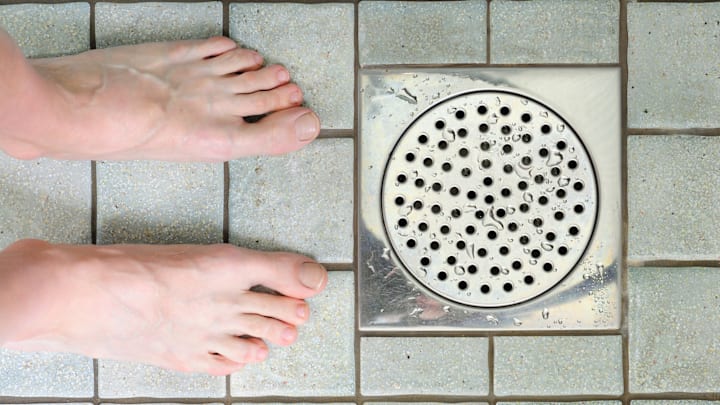Nearly every sport—basketball, tennis, and even bowling—has a specific shoe designed for it, so it was only a matter of time before the thing you do after playing sports (i.e., showering) secured some kicks of its own.
Shower shoes are arguably the most casual and humble form of footwear in existence. We put them on when we’re at our stinkiest, and they only seem to function well when cascading water hits the tile floor in a locker room shower. Tennis shoes can fake it outside the context of a court, but wearing shower shoes anywhere outside of a bathroom makes you look like the guy who shows up to work in a bathrobe.
Why would someone invent such a hyper-specific shoe? As gross as they may seem, their original intention was actually hygienic in nature. In fact, we still wear them today for that reason.
When were shower shoes invented?
While shower shoes are a mostly modern creation, sandals in various forms have existed for thousands of years. They’re often linked to the ancient Egyptians, Greeks, and Romans, though the earliest known pair was found in what is now Oregon and dates back approximately 10,000 years. Were those ancient sandals used like shower shoes? Probably.
True credit for creating the first pair of shower shoes belongs to Adidas. In the early 1960s, the German national soccer team needed something to wear in the shower to prevent athlete’s foot. By 1963, Adidas founder Adi Dassler delivered the answer: a pair of lightweight, waterproof sandals with foam in the soles, which dried quickly and were safe to wear around tubs, pools, and shower stalls.
Adidas Slides or Adilettes (there are numerous combinations) are generally considered the first shower-safe footwear. The simple slip-on sandals had suction pads on the soles to prevent slipping, molded footbeds, and the familiar three strips across the top strap.
They were released to the general public in 1972, shortly before the Summer Olympics in Munich, Germany. Athletes loved them, often using them as a sort of transitional shoe between locker rooms and sporting events. (But not at the events themselves; winning the 100-meter dash with wet flip-flops is hard.) The far less athletic public also took to them, often bringing Slides to the beach to navigate painfully hot sand.
Can you wear shower shoes in the shower?
Gyms, pools, and athletic facilities can be breeding grounds for all kinds of harmful germs, leading to everything from athlete’s foot to plantar warts. Not only can you wear shower shoes in the shower, but you should probably do so every time you hit the water. Most experts agree it can be an excellent way to maintain good hygiene and protect yourself, especially in communal settings.
Over time, the design for shower shoes has evolved too, with Adidas adding adjustable straps and higher edges to keep the foot in place. The brand’s infamous Adissage Slides go even further. They feature massage nubs on the footbed and though they’re intended to knead aching feet therapeutically, many find those nubs to be a somewhat softer version of a bed of nails and tend to take faster showers in order to fling them off as soon as possible. (Perhaps it’s like walking on hot coals, and you learn true inner strength in the process.)
You can also purchase shower shoes from numerous brands now, not just Adidas. Some even look more like socks or slippers and are designed to help prevent falls. Others might opt to wear Crocs in the shower because they’re waterproof, but you should be careful with those, as their unique shape and design means soap and water often pools up in the toe area, making them a potential slip hazard.
Regardless, they’re a familiar sight around gyms, dorms, and any slippery area where people don’t want their bare feet touching the ground. They shepherd us from wet to dry land while safeguarding our delicate feet along the journey and signal more than any piece of clothing that we’re definitely not in a rush. Except, of course, if someone rips off your towel.
Discover the Origins of Other Fascinating Fashion Trends:
